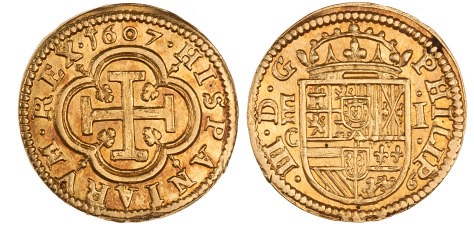
PREV ARTICLE
NEXT ARTICLE
FULL ISSUE
PREV FULL ISSUE
COINS IN DON QUIXOTE
There are books on the coins mentioned in the works of William Shakespeare, blogs on coins mentioned in Sherlock Holmes stories. But did
you know coins play a part in one of the greatest novels of all time, Don Quixote? While visiting the American Numismatic Society
recently, researcher Chad Leahy sat down with blogger Matthew Wittmann and discussed the connection. -Editor
What brings you to the ANS today? I am working on a book project right now about the representation of Jerusalem in early modern Spanish culture and how the politics and interests of Spain in the Holy Land were refracted in art and literature. I also am finishing up an article on the place of coins in a particular episode of Don Quixote that deals with the expulsion of the Moriscos. In the 16th Century, ‘Morisco’ was a term used to refer to the descendants of Muslim people in Iberia, who were expelled from Spain in 1609-1614. Moriscos were officially converts to Christianity, but most of them only nominally so. One of the characters in the novel, Ricote, was a Morisco who was expelled but then sneaks back to recover some buried treasure. The buried treasure of Ricote has been studied a lot from an economic angle, but I am looking at what happens when we read the coins as objects–looking at the marks and inscriptions on them to see the propagandistic messages that were circulating at the time. The discourses used to justify the expulsion were connected to Crusade propaganda and ideas about Spanish national identity, and these same messages are communicated through those coins. So there’s an interesting ironic tension between the character’s own biography and the coins he is coming back to recover. The thing that got Ricote expelled in the first place is stamped on his coins. In Don Quixote, Ricote has all different kinds of money. Most of his money is in the form of escudos and initially I was just surprised by how small escudos are. The expulsion of the Moriscos happened under the reign of Philip III (1598-1621) and the ANS has an escudo from that period and also a gold Portuguese cruzado from a little bit earlier. 
Both pieces are really fascinating. In the heraldry of the period there is a particular kind of cross called the cross potent that was a mark of the crown of Naples, which was in turn connected to both the crown of Jerusalem and the crown of Aragon through marriage and conquest. The cross potent came to represent the Kingdom of Jerusalem. These coins have crosses potent on them and the reason why this is significant in the period as it relates to propaganda and the expulsion is that this particular kind of cross gestures to Crusader propaganda and the idea of universal battle against Islam. It embodies the idea that Spain is destined to reconquer Jerusalem. These kinds of ideas were used to justify the expulsion of the Moriscos in 1609 and this is a connection I want to highlight. To read the complete article, see:
Wayne Homren, Editor The Numismatic Bibliomania Society is a non-profit organization promoting numismatic literature. See our web site at coinbooks.org. To submit items for publication in The E-Sylum, write to the Editor at this address: whomren@gmail.com To subscribe go to: https://my.binhost.com/lists/listinfo/esylum All Rights Reserved. NBS Home Page Contact the NBS webmaster 
|